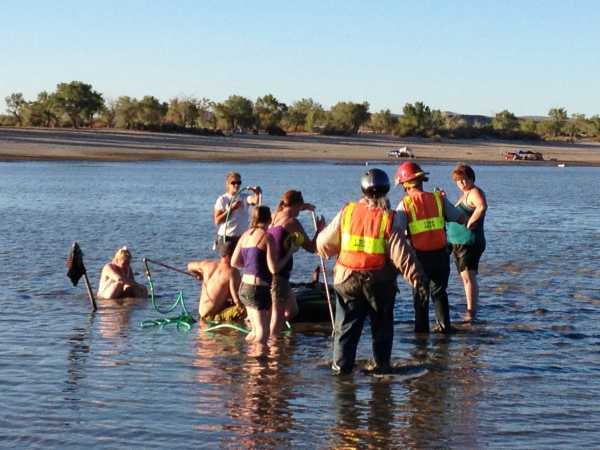|
(Memo to self: Don't ever again mention that the number of horse rescue calls coming in seems to be slowing down.)
Lake Lahontan in Lyon County, NV is a popular summer spot for beach-goers, boaters and equestrians. In late summer and fall, the lake recedes exposing large sandy beaches. The lower lake bottom is sandy with a light slope, creating a fun location for beach-goers to splash and equestrians to ride.
Lake Lahontan, like many sandy bottom lakes, has occasional strata along the lake floor where the sand behaves like quicksand. At Lahontan these "boggy spots" are not dangerous to humans, but they can certainly trap horses.
Shortly after midday, an equestrian riding a 17 hand, 2,300 Lb. Belgian discovered the perils of taking a large horse out into the lake and the horse, "Reno" became hopelessly stuck.
State park crews responded to assist, including a brush fire vehicle. It appears that they tried to jet the horse free using a 1 inch booster line. They had the right idea but not the right equipment.
After about three hours of parks personnel and local helpers attempting to free the horse, the facility manager placed calls for technical large animal rescue help.
Our help was requested at 4:49 PM. We advised supervisor Tony Beauregard that we would be getting prepared to respond and that he should call Michael Connell.
Being a holiday weekend, Connell and the technical rescue trailer at the Nevada Division of Emergency Management were not immediately available. A decision was made to respond with LRTC's "older" equipment to tackle the problem. Four LRTC volunteers responded with the portable water supply trailer (that carries the bogged horse equipment) and the support Jeep.
We immediately encountered a congested beach, requiring us to traverse over some soft sand where the portable water supply trailer, that carries 400 gallons of water plus an array of equipment, got stuck in the sand. We had to hand carry our equipment for the last quarter mile.
The scene on our arrival.
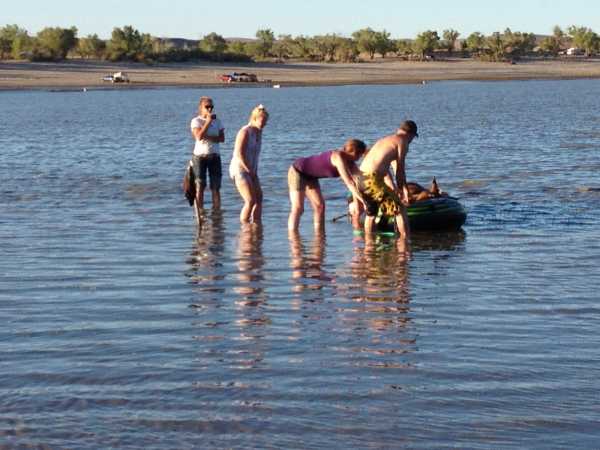
Reno had settled into about three feet of mud and had rolled partially over onto his left side. Someone had acquired an inner tube to keep Reno's head afloat. A pickup with a winch was parked on a nearby beach. The pickup was anchored to a State Parks vehicle for increased stability.
Organizing the rescue. A rag covered shovel handle indicates the boggy area.
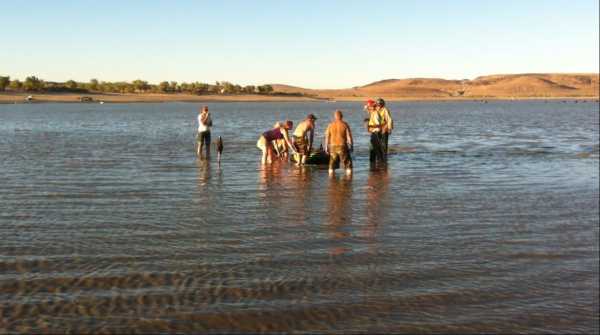
We immediately realized that this incident was going to be Sunday afternoon at the Improv. It was impossible to work in boots or shoes without rescuers and helpers getting stuck, so everyone in the water had to work barefoot.
Our first technical action involved placing four jetting wands in service using water supplied by the State Parks brush engine, and rigging a forward assist sling. We attempted to locate Reno's legs under water and we applied the water.
Setting up the jetting wands.
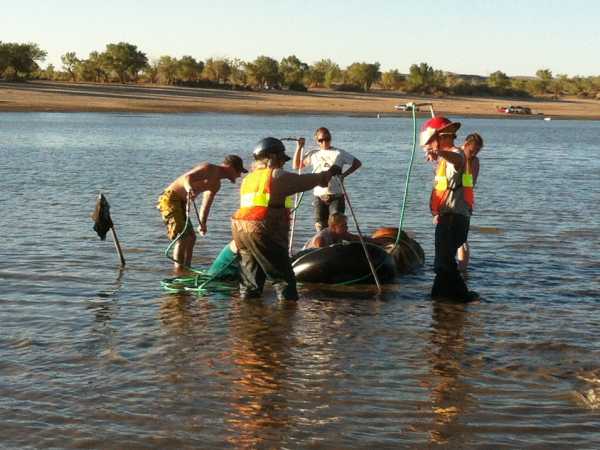
The assist strap was attached to the winch cable and tension was applied but the horse still would not move. Reno's legs were somewhat tangled up underneath him at about a 45 degree angle. We had to rethink our strategy.
Reassessing the situation.
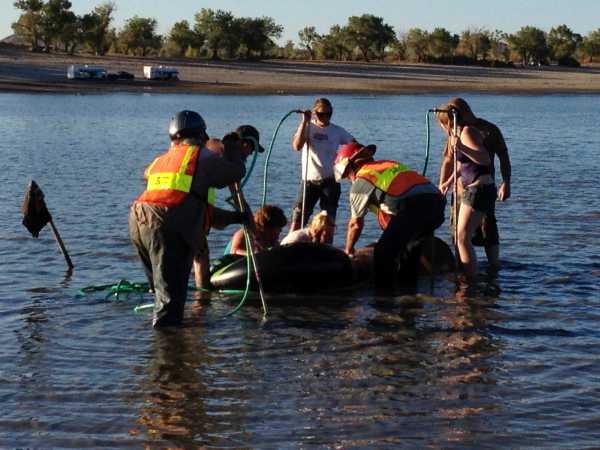
We adjusted our assist straps to create a combination of forward assist and sideways drag. We jetted around the horse's legs again and hoped we could slide him out. That approach was also unsuccessful.
We opted to tunnel down around the horse's lower legs, get lifting ropes around them and use the jetting wands in a form of hydraulic mining operation to blow the sand and muck away from his legs. This operation required someone to actually dive under water to pass the ropes around Reno's legs. One of Reno's owners accepted that task. Given that the horse was stuck fast at the time, such a strategy was reasonable. Meanwhile the parks fire truck refilled its tank from the now stuck Portable Water Supply so that it would be ready to supply the "hydraulic mining" operation.
Getting lifting ropes around Reno's legs.
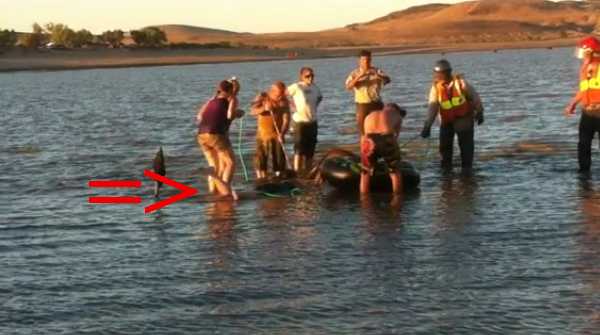
The "mining" operation was successful and within a few minutes the horse could be dragged from the boggy spot onto firmer lake bottom sand.
Rigging a rear sling to rotate Reno out of the bog.
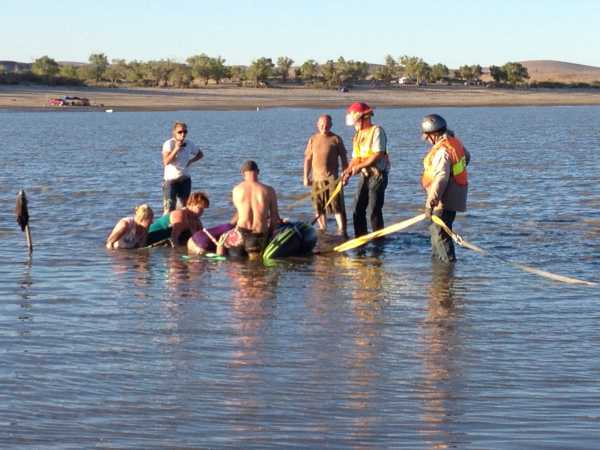
Having been in the water for at least six hours at this time, Reno had insufficient strength to stand so a forward assist sling was rigged.
Employing a forward assist.
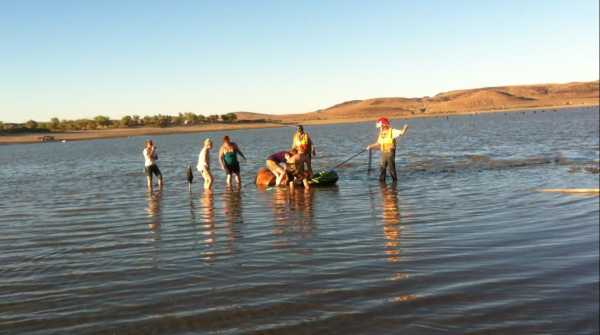
| 



